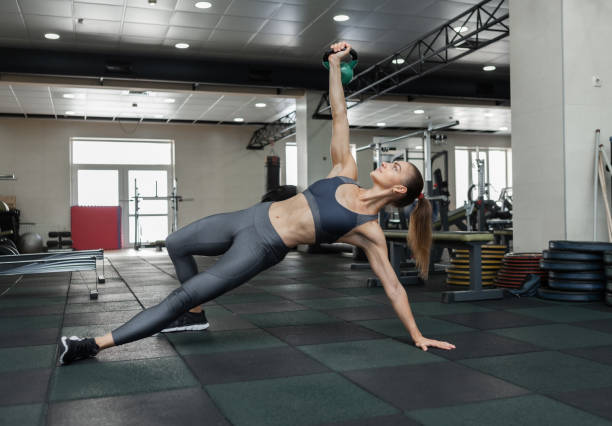
Introduction to Beginner Calisthenics Workout: Getting Started
Are you looking for a fun and effective way to get in shape? Look no further than calisthenics! Calisthenics is an exercise that uses bodyweight movements to build strength and improve fitness. The best part? You don’t need any fancy equipment – just your own bodyweight exercise top. In this beginner’s guide, we will walk you through the basics of calisthenics and provide tips on creating an effective workout routine. Let’s get started!
The Basics of Calisthenics for Beginners
Before designing a ultimate calisthenics workout and routine, let’s cover some basic calisthenics movements. These exercises will be the foundation of any calisthenics workout.
Squats:
- Stand with your feet shoulder-width apart and your toes pointing forward.
- Bend your knees and lower your body until your thighs parallel the ground.
- Stand back up and repeat.
Lunges:
- Stand with your feet shoulder-width apart and take a big step forward with one leg.
- Lower your body until your front thigh is parallel to the ground and your back knee almost touches the floor.
- Push back up and repeat with the other leg.
Push-ups: Get into a plank position with your hands shoulder-width apart. Lower your body until your chest almost touches the ground, and push back up.
Pull-ups: Find a sturdy bar and grip it with your palms facing away. Hang from the bar and pull your body up until your chin is above the bar.
Planks: Get into a push-up position, but instead of lowering your body, hold yourself up with your forearms and toes. Your body should form a straight line from your shoulders to your feet.
Setting Realistic Goals and Expectations
It’s important to set realistic goals for yourself when starting a calisthenics workout routine. Don’t expect to be able to do a ton of push-ups right away – it takes time to build strength. It’s also important to be consistent with your workouts. Aim to do at least 2-3 weekly workouts and gradually increase the intensity as you get stronger.

Designing a Proper Routine for Beginner Calisthenics
Importance of Structure and Consistency
When creating an effective workout routine, structure and consistency are key. Aim to do a full-body workout 2-3 times per week, with a rest day between each workout. It’s also important to incorporate both pushing and pulling movements to ensure you develop strength evenly across your entire body.
Factors to Consider When Creating Your Routine
When creating your calisthenics workout routine, there are a few factors to consider:
Exercise selection – Choose exercises that work multiple muscle groups, such as push-ups, pull-ups, squats, and lunges.
Reps and sets: Aim to do 8-12 reps of each exercise for 3-4 sets.
Progressions: As you get stronger, you must progress to more difficult variations of each exercise.
Rest time: Rest for 30-60 seconds between sets.
Whole-Body vs Split Training: Choosing the Right Approach
Pros and Cons of Whole-Body Training
Whole-body training involves working all major muscle groups in one workout. This approach can be effective for beginners because it allows you to build a solid foundation of strength. However, whole bodyweight exercises can be more time-consuming and require more energy.
Pros and Cons of Split Training
Split training involves working different muscle groups on different days. This approach can benefit more advanced lifters who need to target specific muscle groups. However, for beginners, split training may be optional.
How Should a Beginner Start Calisthenics?
Assessing Your Current Fitness Level
Before starting a calisthenics workout routine, it’s important to assess your current fitness level. Can you do a few push-ups or pull-ups? Can you hold a plank for 30 seconds or more? Use this information to select appropriate exercises and progressions.
Selecting Appropriate Exercises and Progressions
When starting a basic calisthenics workout and routine, it’s important to select appropriate exercises and progressions. Here are a few examples:
Push-ups – If you can’t do a full push-up, start with incline push-ups (where your hands are elevated on a bench or step). Once you can do 3 sets of 12 reps of incline push-ups, progress to knee and full push-ups.
Squats: If you struggle with squats, start with chair squats (sitting down on a chair and standing back up). Once you can do 3 sets of 12 reps of chair squats, progress to bodyweight squats and then weighted squats.
Pull-ups: If pull-ups are too challenging, start with assisted pull-ups (using a resistance band or an assisted pull up bar back-up machine). Once you can do 3 sets of 12 reps of assisted pull-ups, progress to negative pull-ups (where you jump up to the top of the pull-up and lower yourself slowly) and then full pull-ups.
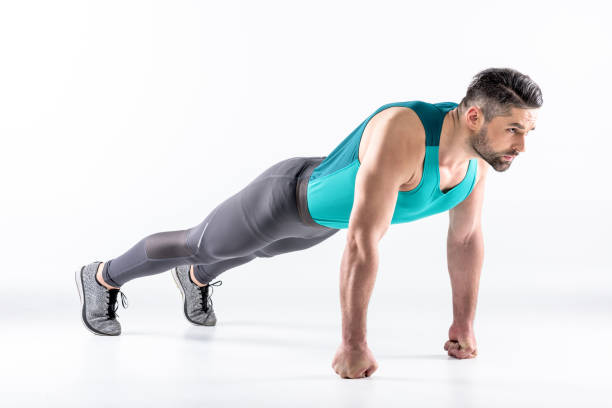
Push Calisthenic Exercises for Upper Body Strength
Push-Up Variations for Beginners
Push-ups are a great calisthenics exercise for building upper body strength. Here are two variations for beginners:
Incline Push-Ups: Place your hands on a bench, step, or sturdy surface about waist height. Lower your body until your chest almost touches the bench, and push back up.
Knee Push-Ups: Start in a high plank position and lower your knees to the ground. Lower your body until your chest almost touches the ground, and push back up.
Developing Shoulder and Chest Strength with Push Exercises
In addition to push-ups, there are a few other exercises you can do to develop shoulder and chest strength:
Pike Push-Ups – Start in a downward dog position with your hands on the ground and your hips in the air. Lower your head to the ground and push back up.
Dips:
- Find two parallel bars (such as dip bars or parallel bars at a playground).
- Grip the bars and lower your body until your elbows are at a 90-degree angle.
- Push back up.
And there you have it! A beginner’s guide to calisthenics that will help you build strength and improve your fitness. With consistency and hard work, you’ll be doing more advanced exercises and movements in no time.
Building Lower Body Strength with Squats
Squats are one of the best calisthenics exercises for building strong legs, glutes, and core muscles. Here’s how to perform a proper squat:
Proper Squat Technique for Beginners
1. Stand with your feet slightly wider than shoulder-width apart.
2. Engage your core muscles, keep your chest up, and lower your body as if sitting back in a chair.
3. Keep your knees behind your toes and evenly distribute your body weight throughout both feet.
4. When you reach a comfortable depth, push back up to a standing position, squeezing your glutes at the top.
Squat Progressions and Variations
Once you’ve mastered the basic squat, it’s time to challenge yourself with some variations to increase your strength and mobility. Some squat progressions that you can try include:
1. Pistol Squat – a one-legged squat that requires balance and coordination
2. Jump Squat – add plyometric power to your leg workout
3. Sumo Squat – a wide-stance squat that targets your inner thighs
4. Bulgarian Split Squat – a lunge variation that targets your glutes and quads
Understanding Progression in Calisthenics Workouts
In calisthenics training, progression is essential for continuous improvement and avoiding plateaus in your fitness level. Here’s why and how you should progress in your calisthenics practice:
Importance of Progression for Continuous Improvement
Every time you perform a calisthenics exercise, your body adapts to the stress and becomes more efficient. To prevent your progress from plateauing, you must challenge your body with new variations or difficulty levels of advanced calisthenics exercises.
Strategies for Progressing in Your Calisthenics Practice
Some strategies for progressing in your calisthenics practice include:
1. Adding reps – Try to perform one more rep than you did in the previous workout for every workout.
2. Reducing rest time – gradually decrease the rest time between sets to increase endurance.
3. Increasing difficulty – try a more challenging exercise variation or use a weight vest or resistance band.
Determining the Ideal Duration of a Calisthenics Workout
The duration of your calisthenics workout will depend on your fitness level, goals, and available time. Here’s how to balance intensity, volume, and recovery:
Factors Influencing Workout Length
Some factors that can influence the length of your first calisthenics workout for beginners, include:
1. Available time – how many minutes per day or week you can commit to your workout.
2. Fitness level – the intensity and volume of your workout should match your current fitness level.
3. Goals – are you trying to build strength, lose weight, or improve your endurance?
Balancing Intensity, Volume, and Recovery
As a beginner, it’s essential to start slow and focus on proper form to avoid injury. A 30-minute workout that includes 2-3 exercises performed with proper technique and strategic rest intervals will provide adequate stimulus for muscle growth and conditioning.
Mastering Incline Push-Ups for Beginners
Push-ups are another essential calisthenics exercise that targets your chest, shoulders, and triceps. However, they can be challenging to perform for beginners, so incline push-ups are a great starting point. Here’s how to master incline push-ups:
Benefits and Technique of Incline Push-Ups
1. Find an elevated surface, such as a bench or table.
2. Place your hands shoulder-width apart on the surface and step back into a push-up position.
3. Lower your full bodyweight squat until your chest touches the surface, then push back up to starting position.
4. Be sure to engage your core and keep your hips parallel to the ground.
Progressing from Incline Push-Ups to Standard Push-Ups
Once you can perform 3 sets of 15 incline push-ups with proper form, you’re ready to progress to standard push-ups. Start by performing 1-2 standard push-ups at a time, gradually increasing the number of reps each workout.
Crafting the Best Calisthenics Beginner Workout Routine
Now that you’ve learned some essential exercises and techniques, it’s time to create a workout routine that suits your fitness level and goals. Here are some essential exercises and a sample workout plan:
Essential Exercises for a Balanced Routine
1. Squats – 3 sets of 15-20 reps
2. Incline push-ups – 3 sets of 10-15 reps
3. Lunges – 3 sets of 10-20 reps per leg
4. Plank – hold for 30-60 seconds
5. Glute bridges – 3 sets of 10-15 reps
Sample Workout Plan for Beginners
Perform each exercise for the specified reps and sets, with a 60-second rest interval between sets:
1. Squats – 3 sets of 15 reps
2. Incline push-ups – 3 sets of 10 reps
3. Lunges – 3 sets of 10 reps per leg
4. Plank – hold for 30 seconds
5. Glute bridges – 3 sets of 10 reps
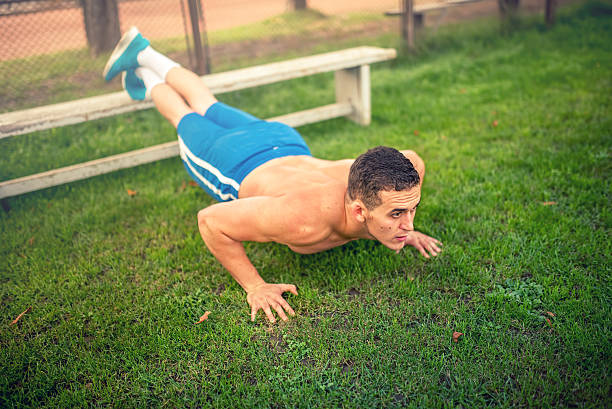
Implementing a Classic Push-Pull-Legs Calisthenics Workout
Understanding the Push-Pull-Legs Approach
The push-pull-legs approach is a common gym routine focusing on training different muscle groups. You have one workout focusing on pushing exercises, one for pulling exercises, and one for your legs. The idea is to give each muscle group enough time to recover before you work them again.
Designing an Effective Push-Pull-Legs Routine for Beginners
When designing your own push-pull-legs routine, remember that you don’t have to make fancy moves or have access to weights. Here’s a sample routine that you can try:
Push:
– Push-ups (3 sets of 10 reps)
– Triceps dips (3 sets of 10 reps)
– Pike push-ups (3 sets of 10 reps)
Pull:
– Australian pull-ups (3 sets of 10 reps)
– Bodyweight rows (3 sets of 10 reps)
– Reverse snow angels (3 sets of 10 reps)
Legs:
– Squats (3 sets of 10 reps)
– Lunges (3 sets of 10 reps each leg)
– Calf raises (3 sets of 10 reps)
Remember to give yourself at least one rest day between workouts, and don’t be afraid to modify the exercises to fit your strength level.
The Secret to Improving in Your Calisthenics Practice

Overcoming Plateaus and Staying Motivated
Sometimes, it can feel like you’re not progressing in your workout. You might reach a plateau where you’re not getting stronger or not seeing any changes in your body. This is very normal, and you can overcome it by mixing up your routine. Add new exercises to your workout, or increase the intensity of your workouts.
Tips for Consistent Progress and Improvement
The key to consistent progress is to make sure that you’re always challenging yourself. Don’t be afraid to try new exercises or increase the number of reps or sets you do. Also, don’t forget to give yourself enough rest between workouts so that your muscles can recover and grow stronger.
A Comprehensive Calisthenics Workout Plan for Beginners
Weekly Schedule and Exercise Selection
If you’re serious about calisthenics, you should aim to workout at least three to four times a week. Here’s a sample weekly schedule that you can use:
Monday:
– Warm-up (5-10 minutes of jogging or jumping jacks)
– Push exercises (3 sets of 10 reps each)
– Pull exercises (3 sets of 10 reps each)
– Leg exercises (3 sets of 10 reps each)
– Cool down (5-10 minutes of stretching)
Wednesday:
– Warm-up (5-10 minutes of jogging or jumping jacks)
– Push exercises (3 sets of 10 reps each)
– Pull exercises (3 sets of 10 reps each)
– Leg exercises (3 sets of 10 reps each)
– Cool down (5-10 minutes of stretching)
Friday:
– Warm-up (5-10 minutes of jogging or jumping jacks)
– Push exercises (3 sets of 10 reps each)
– Pull exercises (3 sets of 10 reps each)
– Leg exercises (3 sets of 10 reps each)
– Cool-down (5-10 minutes of stretching)
Adjusting the Plan as You Progress
As you get stronger, you can adjust your workout plan to fit your new strength level. Increase the number of reps or sets you do, or add more difficult exercises to your routine. You can also incorporate rest days or active recovery days to give your body the time it needs to recover and strengthen.
Starting with Beginner Calisthenics Exercises: Examples of Progressions
Push-Up Progressions for Upper Body Strength
Push-ups are an excellent exercise for building upper body strength. If you’re just getting started, try these push-up progressions:
Wall push-ups -> Incline push-ups -> Knee push-ups -> Standard Push-ups -> Diamond push-ups -> Weighted push-ups
Pull-Up Progressions for Back and Bicep Development
Pull-ups are a tough but effective exercise for developing your back and biceps. If you’re new to pull-ups, start with these progressions:
Negative pull-ups -> Jumping pull-ups -> Assisted pull-ups -> Standard pull-ups -> Wide-grip pull-ups -> One-arm pull-ups
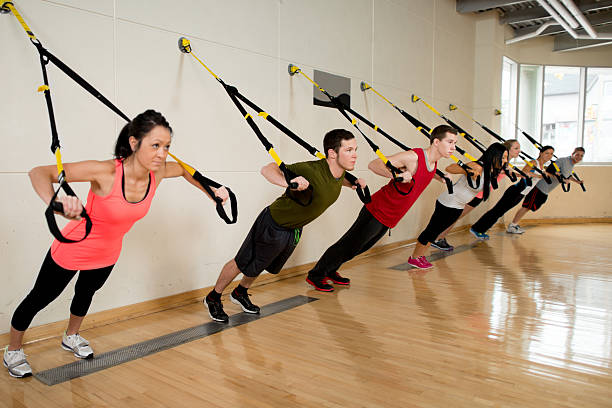
Incorporating Resistance Band Pull-Ups into Your Routine
Benefits of Resistance Band Pull-Ups for Beginners
Resistance bands are great for beginners who want to work on their pull-ups. They assist and can help you develop the strength you need to do a pull-up independently.
Proper Technique and Progression Strategies
When using resistance bands for pull-ups, make sure you’re using the correct technique. Place the band around the bar or doorframe and loop one leg through the band. Grab onto the bar and pull your body up. As you get stronger, you can gradually decrease the band’s resistance until you can do a pull-up without any assistance.
And there you have it – a beginner calisthenics workout guide! Remember to listen to your body and avoid pushing yourself too hard. With consistent practice and dedication, you’ll be amazed at how much progress you can make without equipment. Happy exercising!
Calisthenics vs Weights: Which is Better for Beginners?
When building strength, should you focus on calisthenics or weight training? While doing bodyweight training both have benefits, calisthenics can be a great option for beginners.
Advantages of Starting with Calisthenics
Calisthenics is a great way to build strength and improve mobility without equipment. It’s also a more functional form of strength training, as you use your own body weight, in natural movements. Plus, calisthenics can be done anywhere, making it a convenient option for busy schedules.
Considerations for Incorporating Weight Training
While calisthenics can be a great stand-alone workout, there is also value in incorporating weight training into your routine. Using weights can help build strength in a more targeted way and can also be a great way to add variety to your workouts. If you’re going to be weightlifting, it’s important to have a proper form, as weights can put more stress on your muscles and joints.
Three Lower Body Beginner Calisthenics Exercises
Let’s dive into some specific beginner calisthenics exercises for your lower body.
Exercise #1: Squats
Squats are a basic exercise that works your lower body, particularly your quads, hamstrings, and glutes. To perform a basic squat, stand with your feet shoulder-width apart, toes pointing slightly outwards. Lower your body down as if sitting into a chair, keeping your chest lifted and your knees bent, tracking over your toes. Push through your heels to stand back up and repeat.
Exercise #2: Lunges
Lunges are another lower body exercise that targets your quads, hamstrings, and glutes. To perform a walking lunge:
- Step forward with one foot and bend both knees to lower your body down towards the ground.
- Keep your front knee tracking over your toes and your back knee hovering just above the ground.
- Push through your front heel to step forward with your back foot and repeat on the other side.
Exercise #3: Calf Raises
Calf raises are an exercise that targets your calf muscles. Stand with your feet hip-width apart and slowly rise onto your toes, then lower back down. You can perform these with both feet or one foot at a time.
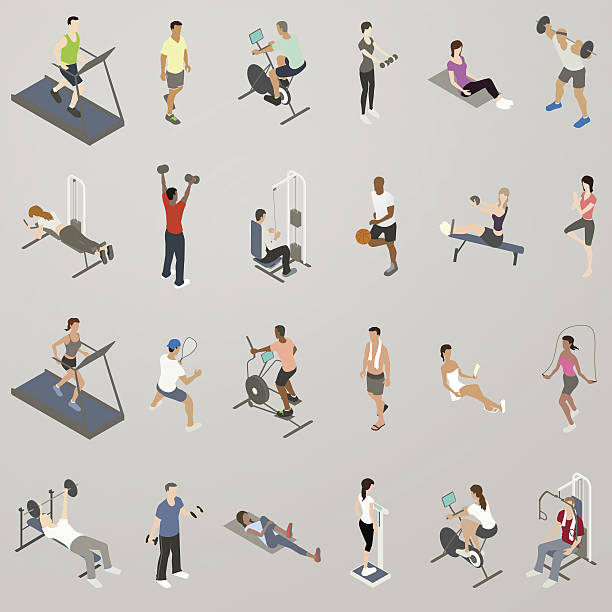
Circuit Training for Beginners: Boosting Endurance and Strength
One way to combine all of these exercises into a challenging workout is through circuit training.
Basics of Circuit Training in Calisthenics
Circuit training involves performing a sequence of exercises with little to no rest and repeating the circuit multiple times. This type of resistance training can be great for improving endurance and strength. Plus, it’s fun to mix things up and keep your workouts interesting.
Sample Beginner Circuit Training Workout
Here’s a sample circuit training workout that incorporates some of the exercises we covered:
– 10 squats
– 10 lunges (each leg)
– 10 glute bridges
– 10 calf raises
– Repeat the circuit 3-4 times with minimal rest in between.
Remember to focus on proper form during each exercise and progress at your own pace. With consistent practice, you’ll be able to build strength and see improvements in your fitness level. Good luck on your calisthenics journey!


Leave a Reply